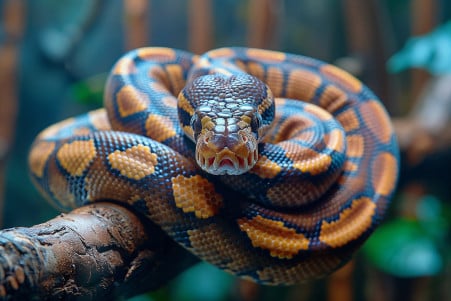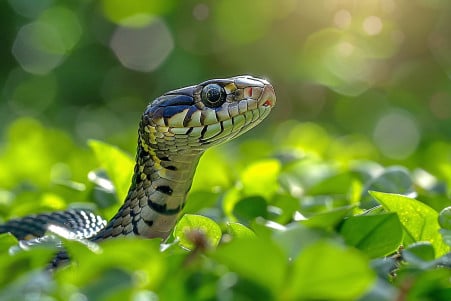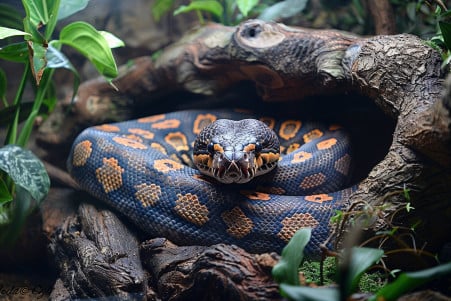Ball Python Feeding Schedule: How Often to Feed Based on Age and Size
7 June 2024 • Updated 6 June 2024

How often you feed your ball python matters and can impact their well-being. That said, there are several things to consider when determining how often to feed your ball python, including their age, size, and how they respond to feeding. In general, most adult ball pythons should be fed prey that's an appropriate size every 7-14 days, while younger ball pythons that are still growing may need to eat twice a week. That said, it's important to pay attention to your snake's body and how often they seem hungry to determine how often to feed them.
To help you figure out how often you should feed your ball python, we'll take a deep dive into the research of experienced reptile veterinarians and herpetoculturists. These experts have studied everything from ball pythons' feeding habits in the wild to how fast they grow at different ages and the best size for their prey. Armed with this information, you'll be able to develop a feeding schedule that meets your ball python's needs at every stage of their life, ensuring they stay healthy and strong.
How often should you feed a ball python?
How to Switch to Frozen-Thawed Prey
Reptile experts recommend switching a ball python to frozen-thawed prey for both safety and convenience. As WHERE MY SCALES SLITHER explains, frozen prey eliminates the risk of bites or scratches and lets you stock up. However, it will take time and effort to make the switch.
The most important thing is to switch gradually, starting with pre-killed prey and then moving on to frozen prey that's been thawed and warmed properly. Never just drop a cold frozen rodent into the enclosure, as ball pythons can be finicky and may not eat it, cautions Northwest Reptiles. Instead, warm the prey to about the snake's body temperature before offering it.
Techniques like the "zombie dance," which involves wiggling the thawed prey with tongs, can help stimulate the feeding response, according to WHERE MY SCALES SLITHER. Scenting the prey with soiled bedding or "braining" it by piercing the skull can also be effective. You can also use long tongs or hemostats to make the prey appear to be alive. Keep a close eye on your snake's weight and appetite as you work to switch it to frozen-thawed prey.
Dealing With Inappetence and Feeding Refusal
Ball pythons may refuse to eat for a number of reasons, including health problems, stress, and environmental factors. For example, as pointed out by ReptiFiles, some of the most common reasons for inappetence include incorrect habitat conditions, shedding, breeding season, and recent importation.
To make sure the snake doesn't lose too much weight, it's important to keep a close eye on its weight and body condition, according to Terrarium Quest. You can also try different prey options, sizes, and ways of presenting the prey to the snake to see if it will eat. Scenting the prey and using tongs to make the prey appear to be alive can be effective, as pointed out by Reptilinks.
If the ball python goes for a long time without eating, it's time to consult a vet. A vet can help determine if there are any health issues that are causing the inappetence and can help you treat them. In addition, as you'll learn in the next section, making sure the snake's habitat is set up correctly is important for ensuring that it will eat.
Setting Up the Right Ball Python Enclosure
Ball pythons need a spacious enclosure with the right heating, lighting, and humidity conditions to be healthy and happy. According to Reptile Supply, the smallest recommended size for an adult ball python is 48"L x 24"W x 24"H, although larger is always better. The enclosure can be wood, PVC, or plastic, but it should be front-opening and have plenty of ventilation.
The best substrates for the enclosure are cypress mulch, coconut fiber, or DIY tropical mixes, as recommended by XYZReptiles.com. In addition to these substrates, hiding places, branches, and a water bowl, and maintaining the right temperatures and humidity levels are important for the snake's health and feeding response, according to Terrarium Quest.
Creating a habitat that mirrors the ball python's natural environment in West and Central Africa, which includes grasslands, scrublands, and open forests, can make a big difference in how the snake behaves and feels. Making sure the habitat is set up correctly is the first step in being a great owner to these amazing animals.
How to Keep Your Ball Python Healthy
According to ReptiFiles, the most important way to keep your ball python healthy is to make sure their habitat is clean and that they are kept in the right temperature and humidity conditions. Common health problems in ball pythons include respiratory infections, skin infections, parasites, and inclusion body disease.
In addition to these measures, it's important to regularly check your snake's weight, behavior, and shedding to make sure that they are healthy, as pointed out by Terrarium Quest. If you notice any signs of injury or disease, it's important to take your ball python to the vet.
Finally, it's important to make sure that you are following proper husbandry and quarantine protocols to prevent the spread of disease, according to VCA Animal Hospitals. This includes cleaning the enclosure, perches, and bedding to make sure that your snake is not exposed to parasites like mites.
By keeping a close eye on your snake's environment and health, you can make sure that you catch any potential health problems early and ensure that your snake lives a long and healthy life.
Ethics of Ball Python Breeding
Ball python breeding should be done responsibly and with a focus on animal welfare, says Northwest Reptiles - Ball Python breeder. This means that breeders should make sure to maintain genetic diversity and not overproduce or contribute to overpopulation.
Some of the common challenges and difficulties of breeding ball pythons include breeding refusal, infertility, egg-laying problems, and genetic health issues, according to the same source. Breeding is only successful when breeders have the knowledge, experience, and commitment to the animals' well-being.
Ethical breeders will encourage responsible pet ownership and avoid impulse buying and selling, which can lead to the spread of disease and negatively impact the long-term health of captive ball pythons. By focusing on animal welfare and genetic diversity, breeders can help ensure a bright future for these amazing animals.
Conclusion: How to Make Sure Your Ball Python Gets the Best Care Through Feeding
Ball pythons have different feeding requirements based on their life stage and size. Hatchlings and juveniles (up to 1 year) need to be fed every 5-10 days to support fast growth, according to the Ball Python Complete Food Guide – Zen Habitats. Subadult and young adult ball pythons (1-2 years) can be fed every 10-14 days, while mature adult ball pythons (3+ years) can be fed every 2-3 weeks or even longer, according to Terrarium Quest.
The prey item should be about 10-15% of the snake's body weight, according to ReptiFiles' Ball Python Care Guide. Feeding frozen-thawed prey is generally the best option because it's safer and more convenient for the owner.
If you're trying to switch a ball python from live to frozen-thawed prey, it's important to be patient and use the right methods, including the "zombie dance" and scenting, which are explained by WHERE MY SCALES SLITHER and Northwest Reptiles. It's also important to carefully monitor the snake's weight and feeding response during this time.
Ball pythons may stop eating for a number of reasons, including health problems, stress, and environmental issues, according to ReptiFiles, Terrarium Quest, and Reptilinks. Making sure that the habitat is set up correctly and kept clean is important for preventing health problems and ensuring that the snake eats regularly.


